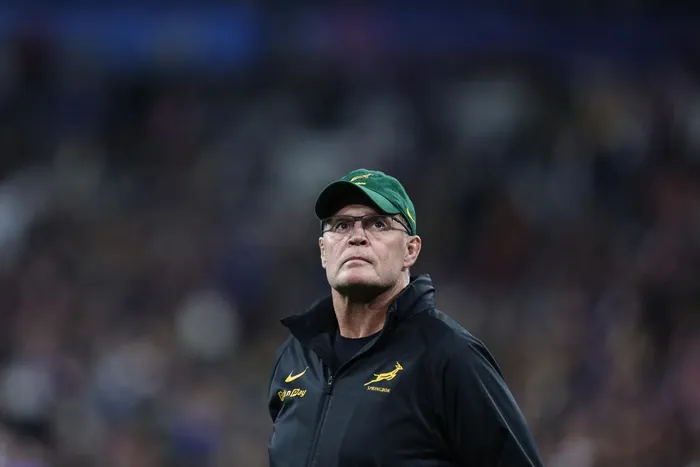Inconsistent head-contact officiating and red card calls threaten rugby's integrity
COMMENT

Springboks coach Rassie Erasmus had to choose his words carefully following a second highly questionable red card in as many games for the Springboks this past weekend against Italy.
Image: AFP
Red cards are not ruining rugby — inconsistent officiating is.
And the sooner the sport’s powerbrokers admit that, the sooner we can stop pretending that the chaos unfolding weekly across Test arenas is anything other than a failure of interpretation and consistency.
This past weekend once again exposed the gulf in how referees and TMOs deal with head-contact incidents, and how the colour of a jersey — or the hemisphere a team hails from — too often appears to influence outcomes.
The narrative that strict sanctioning is protecting players and the safety of the game is only believable if those sanctions are applied evenly. Right now, they’re not.
Take Franco Mostert’s straight red card against Italy on Saturday.
Officials claimed head contact. The replays suggested something else: no clear contact to the head of the tackled player and certainly nothing warranting a full red. It should have been play-on in fact. Yet Mostert walked, and South Africa was forced to play with 14 men. Despite that, they claimed a brilliant fighting victory.
Contrast that with the incident moments after Handré Pollard’s drop-goal attempt that went over, when Italian centre Juan Ignacio Brex charged into prop Wilco Louw with a forearm that caught the Bok prop square in the head.
Instead of sanctioning the obvious act of leading-arm contact, the TMO — a Frenchman — decided Louw was guilty of obstruction. Brex went down theatrically, Serie A football-style, and somehow the Springboks were the ones punished. Later on in the match, Kwagga Smith was tackled by an upright Italian defender with a resulting clash of heads, only a yellow card.
Clear head contacts on one side is ignored or punished softly; perceived contact on the other is upgraded to red. How does that make sense?
The inconsistencies weren’t limited to that Test.
In Fiji vs France, a French replacement prop flew into a ruck and cleaned out a Fijian player with a fully tucked shoulder. The Fijian was legally over the ball. The shoulder made direct contact. Nothing was given. No yellow, no bunker review, not even a penalty.
In Ireland vs the Wallabies, flyhalf James O’Connor absorbed a thunderous shoulder to the face enough to visibly ripple his cheek on impact. Again, no sanction followed. Somehow, those incidents don’t meet the threshold, but Mostert’s collision does.
Then there’s the incident of Wales winger Josh Adams, who received a 20-minute red card for a clear shoulder-to-head clear-out — one that should have been a straight sending-off.
He targeted a vulnerable player, never attempted to play the ball, and his actions were always illegal. Adams executed a textbook example of dangerous foul play. Yet his sanction expired after 20 minutes, while Mostert’s apparently warranted a full red card and all its consequences.
The pattern is impossible to ignore: southern hemisphere teams, including South Africa and Fiji, are being refereed to a different standard. Actions are dissected frame-by-frame, while similar — often worse — incidents involving northern teams are glossed over with remarkable speed.
As an example, head contact to Bok captain Siya Kolisi was not checked, despite being asked for, while the incident involving the Fijian was also waved away with no look-again, despite it being asked for by the skipper of the team.
It is becoming farcical and if World Rugby remains silent — and too often they are — they should not be shocked when coaches, players and unions begin calling out the imbalance publicly.
The game is drifting into dangerous territory, and unless there is immediate intervention, inconsistent officiating will do more damage to rugby’s aura and integrity than any red card ever could.
Related Topics: